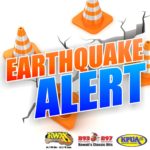
On Wednesday June 2, 2021, the U.S. Geological Survey’s Hawaiian Volcano Observatory (HVO) recorded a magnitude-4.0 earthquake located beneath Lō‘ihi seamount that took place at 6:44 p.m.
The earthquake was centered about 42 km (26 miles) southeast of Nāʻālehu, under Lō‘ihi seamount at a depth of 11 km (7 miles). Moderate shaking, with maximum Intensity of V on the Modified Mercalli Intensity Scale, has been reported across the Hawaiʻi Island. At that intensity, significant damage to buildings or structures is not expected.
According to HVO Scientist-in-Charge Ken Hon, the earthquake had no apparent effect on Kīlauea or Mauna Loa volcanoes. In a statement Hon said, “we see no detectable changes in activity at the summits or along the rift zones of Lōʻihi, Kīlauea, or Mauna Loa as a result of this earthquake. Aftershocks are possible and could be felt.”
HVO continues to monitor Kīlauea, Mauna Loa, and other Hawaiian volcanoes for any changes.
Lōʻihi seamount is an active volcano on the seafloor south of Kīlauea Volcano, about 30 km (19 miles) from the shoreline of the Island of Hawaiʻi. The top of the seamount is about 975 m (3,199 feet ) below sea level. The volcano consists of a broad summit area marked by three pit craters and two prominent rift zones extending from the summit about 22 km (13.6 mi) south-southeast and about 15 km (9.3 mi) north-northeast. The volcano likely has a shallow magma chamber between 1 to 2.5 km (0.6 to 1.6 mi) deep below the summit. In mid-May 2020, HVO detected more than 100 earthquakes beneath Lōʻihi. The earthquake activity may have represented a brief magmatic intrusion or movement of magmatic fluids within the volcanic edifice
For information on recent earthquakes in Hawaii and eruption updates, visit the USGS Hawaiian Volcano Observatory website at https://www.usgs.gov/hvo.